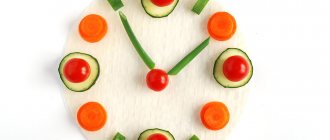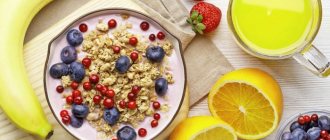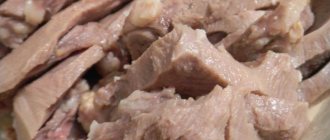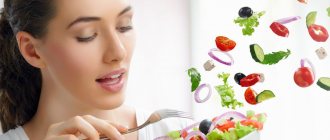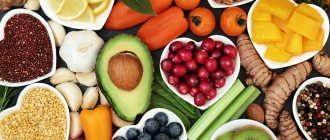Who hasn't heard about proper nutrition? Everyone says it: in the age of healthy food and healthy physical activity, it is impossible not to know about proper nutrition. A diet for weight loss consists mainly of foods that benefit the body, and at the same time, get rid of extra pounds. A PP diet for weight loss can be developed by a nutritionist, but after familiarizing yourself with the basic principles of PP, you can create it yourself. Everything about proper nutrition for weight loss and the right diet for weight loss is in the next article.
Basic nutrition
Many of us suffer from physical inactivity (lack of physical activity and movement), but still eat well.
Many of us suffer from physical inactivity (lack of physical activity and movement), but still eat well. This leads to fat settling on the sides, and when we go to the gym, it turns out that there is absolutely no strength and energy left for training.
With a lack of calories, the effect of training will be very low, which will lead to a loss of strength and reduce the effectiveness of training. Therefore, if you decide to play sports and these activities will be regular, you need to switch to special sports nutrition.
At the same time, your diet largely depends on the type of sport you prefer to engage in and the degree of your fitness. Professional athletes have a special diet, which is selected for them by nutritionists. And yet the general principles of nutrition remain the same:
- Full or partial fasting when playing sports is not allowed; this will deplete the body without leading to any noticeable results.
- First of all, when changing your diet, consult with a trainer or sports doctor; they will know what adjustments to your diet need to be made.
- It is important to avoid overeating and eating in a hurry.
- While eating, you need to concentrate on the process of eating, and not on talking or watching TV.
- Eat when you really want to eat, but not for company or out of boredom.
Mode
Nutritionists and fitness instructors are of the opinion that you need to eat at least four times during the day, and preferably five. There should be an equal period of time between meals, at least two hours and no more than four. This is both convenient and does not lead to overeating. In addition, an equal interval between meals allows the digestive system to reduce the load on the body and improve the absorption of foods.
Four to five meals a day reduce the desire to snack (and we usually snack on various kinds of chips and snacks, not very healthy food). And you need to plan your meal times so that the last meal is no later than two hours before bedtime. This does not mean that you should definitely not eat after six if you go to bed at eleven, but it is worth following the “two hours before bed” principle.
When it comes to organizing proper nutrition at home, you should have a flexible attitude. After all, it is difficult to immediately begin to observe the described principles, and the person will break down. You need to start gradually, gradually removing unnecessary foods from your diet and increasing the amount of useful ones. And most importantly, focus on exactly how we eat, how often, in what quantities. Once your body gets into a routine, sticking to proper nutrition will become much easier. Losing weight is not an end in itself, but only a side effect of correctly applied principles of healthy eating.
To comply with the principles of proper nutrition, it is also important not to remain hungry, which often affects those who are on a diet. Proper nutrition is not a diet, but a way of life that always accompanies a person. Breakfast and lunch should be the most nutritious, and dinner should be light. It is for breakfast that you should eat all the high-calorie foods (carbohydrates), and leave mostly fiber and protein for dinner.
What can be considered correct
- This is food that gives our body all the necessary substances and necessarily contains proteins, fats, carbohydrates, vitamins and microelements. (such favorite chips, pies and soda “alas and ah” do not correspond to this definition, but this does not mean that they are not allowed at all, see point 4).
- Quenches the feeling of hunger. This means there should be enough food to feel full, but not so much that you overeat.
- Diet: the break between meals should be about 3 hours. maximum 4-4.5 hours. A long break in meals leads to overeating. Ideally: eat at the same time. Like in a pioneer camp, remember? The most interesting thing is that we quickly got used to it, the stomach waited for food at the right time and it was digested much better.
- They say that “Sweets are vitamins for the soul.” Is it possible to leave our soul without vitamins? Of course not! But like any medicine, vitamins must be strictly dosed. Therefore, it is better to ideally limit sweets to once a week.
- Food classics: baked, stewed and boiled are preferable to fried and smoked. In my opinion, it just tastes better this way.
“This is all good,” you say, “but can you be more specific?” “With pleasure!” I will answer you. Let's look at a specific example of a healthy nutrition menu for a week.
Features of women's proper diet
Surely you have noticed one fairly common phenomenon: as soon as a man and a woman start living together, the fair sex immediately begins to get better. And this is not at all a matter of a “boring home” lifestyle. It’s just that the diet often becomes common for them, although the body’s needs differ between men and women. Due to less muscle mass, a woman's metabolism is slower, which means that her caloric needs are approximately 15% less[1]. She needs less energy, less protein, fat and carbohydrates.
However, if you pay attention to vitamins, the situation is completely different: for example, a woman needs more iron and vitamin C, which is associated with natural processes occurring in her body.
Also, the female body is more sensitive to irregular meals. A lack of nutrients and vitamins can lead to dire consequences - decreased activity and physical development of the body, immunity, deterioration of the condition of the skin, hair, nails and teeth, suppression of reproductive function, and the development of depressive conditions.
Of course, everything happens gradually, it is quite difficult to immediately notice changes. Women who pay little attention to their diet or periodically resort to strict or simply unbalanced diets have probably noticed “alarm bells”. Quite common examples are pimples, which can be one of the signals of improper bowel function, increased volume of hair on the comb, brittle nails.
It would seem that these are trifles. But are they compatible with the concepts of beauty? First of all, it is worth remembering that our appearance largely depends on the functioning of our internal mechanisms. Working with external manifestations is similar to applying cosmetics - it temporarily hides imperfections. But true transformation begins only from within. Therefore, when preparing a proper nutrition program, including for weight loss, it is necessary to follow certain rules.
What is allowed to eat
In order to avoid digestive disorders directly related to sucrose intolerance, it is necessary to approach the formation of a daily menu with full responsibility. Listed below are food ingredients that contain little or no sugar. These ingredients are safe for the human body with sugar intolerance due to fermentopathy.
The list of permitted ingredients includes the following products:
- Buckwheat and rice cereals, legumes, pasta.
- Canned and fresh green peas, soy sauce, boiled sausage, eggplant caviar, green bell pepper, lettuce, sunflower seeds.
- Dill, parsley, basil, cilantro, cinnamon, oregano.
- Raspberries, cherries, strawberries, red currants, pumpkin pulp.
- Pomegranate, tomato juice and tomatoes, fruit and berry compotes without added sugar.
- Carrots and carrot juice, dried apricots, almonds, ginger, spinach, fresh and pickled cucumbers, wheat and rye bran, zucchini, ginger, olives, peanuts, chili peppers.
- Natural fermented milk products without added sugar, whole milk (subject to lactose tolerance), ice cream and any type of fructose-based confectionery.
- Any types of meat and fish with moderate or low fat content, fish and canned meat.
The ingredients listed contain minimal or no sucrose. In addition, the listed food products have a low glycemic index, which is recommended for people with excess body weight to pay attention to.
Proper nutrition: a menu for every day for weight loss
Proper nutrition: a menu for every day for weight loss
After you eliminate all harmful foods from your life, you will need to replace them with healthy ones, we recommend adding as many fresh vegetables to your menu as possible, replacing fatty meats with more dietary ones, for example, poultry meat (chicken breast, turkey), number of meals increase food to 5-7 per day, and reduce the serving size to 200-250g; do not forget to drink water, which has a positive effect on metabolism and the body.
You need to learn how to calculate the KBZHU - the daily norm of calories, proteins, fats and carbohydrates, suitable for losing weight, at your rhythm of life. This is not so easy to do, but nothing is impossible! You will need a compact food scale to weigh each of the ingredients in your dish, as well as a mobile application in which you will find information about the amount of nutrients in each type of product.
Power Specifications
A therapeutic and prophylactic diet for congenital or acquired sugar intolerance acts as the most effective method of combating the clinical manifestations of fermentopathy. The main goal of the diet is the complete or partial exclusion of foods rich in sucrose from the diet, which allows, in a short period of time, to normalize the general condition, regulate digestive activity and get rid of skin manifestations of fermentopathy.
This diet is not strict and does not have an extensive list of prohibited ingredients. The diet is complete and replenishes the energy costs of the human body in full. The diet should be dominated by natural foods rich in plant fiber, vitamins, minerals, protein and vegetable fats. If a person has an intolerance only to sucrose, then the daily menu includes fermented milk products, which contain bifidum and lactobacilli, which help absorb and break down carbohydrate components.
The therapeutic and prophylactic diet for individual intolerance to sucrose does not provide recommendations for thermal and mechanical processing of food, but it is recommended to prepare the first and second courses baked, stewed, boiled or steamed. In addition to the positive effect on carbohydrate metabolism, a diet for sucrose intolerance has a beneficial effect on the condition of the pancreas, which is responsible for the production of enzymes that break down carbohydrates, proteins and fats.
Is there any benefit from PP?
Undoubtedly, proper nutrition helps maintain and even restore health. The weekly menu contains products that meet the body's needs for nutrients, vitamins and minerals.
The diet can also include foods and dishes that help satisfy increased needs for certain substances, masked as a desire to eat “junk” food.
Researchers have long proven that craving for certain types of dishes and products does not always mean a lack of microelements contained in these dishes. For example, a love for carbonated drinks does not indicate a lack of carbohydrates, but masks a lack of calcium intake from food, and it is necessary to correct it not with Coca-Cola, but with dairy products.
| Desired product | Shortage in the body | Products Suppliers of the Missing Item |
| Fatty dishes, food, carbonated drinks | Calcium | Dairy products (yogurt, cheeses, cottage cheese), legumes, sesame seeds, nuts |
| Whole grain bread, baked goods | Nitrogen | Nuts, beans, beans |
| Chocolate products, cocoa | Magnesium | Cabbage, baked potatoes, seeds, nuts, beans |
| Sweets | Chromium, slow carbohydrates | Fruits, barley (barley porridge), cereal porridges |
| Salt, salty food | Sodium chloride, calcium | Seaweed, cheeses, cottage cheese |
Replacing foods allows you to saturate your body with essential microelements and prevent “breakdowns” from your diet.
Where to start with proper nutrition
There are no special secrets in how to switch to proper nutrition. And most importantly, healthy food does not require additional financial expenses that are beyond the family budget. Healthy food products do not have to be very expensive - it is enough that they are natural and fresh. The whole nuance is how these products will be prepared and consumed.
Products representing all food groups are required in a healthy diet.
Let's start with the fact that long-term heat treatment always “kills” the lion's share of the benefits in any food product. Therefore it should be minimal. We should not forget that fried food, firstly, is a priori of little benefit to the stomach, and secondly, it is harmful due to contact with the fats in which it was cooked - even fresh fat “for one frying” is harmful, and reused “gives” carcinogens! One of the best cooking methods today is a double boiler.
Products representing all food groups (from greens and fruits to beans and oils) are required in a healthy diet. Their percentage may be determined by your taste preferences and the characteristics of the organisms of family members, but diversity and coverage of the entire spectrum is an indispensable requirement for fully providing the human body with vitamins.
Regularity and accuracy in timing of meals is the key to clear “work” not only of the gastrointestinal tract, but also of the entire system as a whole. Eating according to the clock ultimately regulates sleep, the nervous system, and normalizes the condition of blood vessels and blood pressure.
Minimum salt, limiting sugar, controlling buns and cakes, replacing fizzy drinks with herbal tea or compotes - all this is easier to get used to than you think. In 21 days, the human body is completely rebuilt, including in terms of taste preferences.
Snacks in proper nutrition will also undergo changes. Firstly, it is better to forget about frequent consumption of buns, cakes and other flour and sweet products. According to proper nutrition, it is better to have breakfast with porridge, banana, kefir, etc., and put the buns and cakes aside.
In addition, during the day everyone likes to “carry” cookies and sweets around the office, which also leads to the consumption of excess calories, which eventually accumulate in such quantities that they are not burned and are stored in fat folds. No one is saying that you need to completely limit yourself from eating “sweets,” but you need to learn to control their quantity and allow yourself to eat them strictly before lunch.
For a late dinner, proper nutrition advises preparing meat and a green salad. Meat protein remains one of the most useful and almost irreplaceable ingredients, and carbohydrates can be obtained not only from pasta, rice and buckwheat, but also from vegetables. In addition, vegetables contain fiber, which will improve the functioning of the gastrointestinal tract.
What is prohibited
The list of restrictions for liver cancer is, unfortunately, quite long. In addition to such obvious prohibitions as any type of alcohol and fast food, it includes many other products.
High protein meals. Despite the fact that proteins are necessary for patients suffering from oncology, too high a protein content in food is unacceptable. Failure to comply with this requirement leads to further liver damage and increased intoxication. Therefore, the consumption of high-protein foods such as dairy products, eggs, and meat must be strictly controlled.
Fatty meats, sausages, smoked meats, and roasts should be completely excluded from consumption.
Sweet and fatty foods. Unfortunately, if you have liver cancer, you will have to forget about cakes and pastries with cream forever. Such delicacies put even a healthy liver into a state of stress. In case of illness, fat consumption must be limited to a physiological minimum and preference given only to the most easily digestible types.
All kinds of pickles. Excessive salt consumption is extremely detrimental for cancer patients, as the behavior of the tumor becomes more aggressive. Excess salt leads to swelling, including in the liver. Therefore, salt must be strictly limited and in no case exceed the daily allowance.
This is what the diet for liver cancer looks like in general terms. If you, dear readers, liked the article, then do not forget to click on the buttons with the symbols of your favorite social networks and share the links.
Did you like the article? Share with friends on social networks:
This blog is read and used by 6,939 adherents of a healthy lifestyle and uses its advice and recommendations, so their health is in order, their mood is good, and their work is going well. Read it too.
I agree to the newsletter and accept the privacy policy.
You may also be interested
All the subtleties of treating cholecystitis with folk remedies
Greetings, dear visitors to Alexey Shevchenko’s blog “Healthy Lifestyle”. ...
8 Read more
The main symptoms of cervical cancer
Good day, dear readers of Alexey Shevchenko’s blog “Healthy image...
6 Read more
Alcohol intoxication - do not go beyond safe limits...
Good day, dear readers of Alexey Shevchenko’s blog “Healthy image...
18 Read more
Main symptoms of colorectal cancer
Good day, dear readers of Alexey Shevchenko’s blog “Healthy image...
4 Read more
Diet "proper nutrition": losing weight correctly
As with all diets, popular or medical, there are basic principles. They do not contradict the rules of healthy eating; on the contrary, they are mainly based on them. Some of the principles need to be adjusted in accordance with the characteristics of the body and new research in medicine and nutrition, however, this diet allows for minor deviations and can be adapted to the needs of a particular person.
PP principles:
On the PP, it is strictly forbidden to eat food with glutamate additives, sugar substitutes or its abundance
exclusion of semi-finished products, fast food, carbonated drinks, industrial sweets, sausages, canned food, chips, almost all products prepared outside the home and not having the correct ratio of proteins, fats and carbohydrates. It is strictly forbidden to eat food with glutamate additives, sugar substitutes or its abundance;
- salt restriction;
- Every day after sleep, first of all, you need to slowly drink 200-300 ml of warm water;
- dishes are prepared by steaming, baking, boiling, stewing. Fried food is prohibited;
- a fifth of the diet consists of fresh fruits and vegetables;
- almost completely eliminate fast carbohydrates, replacing them with slow-cooking foods: cereals (not instant), bread (whole grain or wholemeal), premium pasta, unsweetened vegetables. Berries, fruits and honey - sources of fast carbohydrates - are included in meals in the morning and afternoon;
- the total volume of animal proteins is calculated by body weight: 1 g of protein should be supplied per 1 kg of weight daily;
- the volume of liquid (preferably water and herbal teas, unsweetened fruit drinks, compotes) is at least 2 liters per day, with a mandatory glass of warm water 30 minutes before each meal;
- carbohydrate meals are distributed for consumption in the first half of the day, protein - in the second;
- It is recommended to consume only polyunsaturated fats: olive, flaxseed oil, fish (salmon, trout), seeds, nuts, avocados, etc. The total volume is 1/5 of the daily diet;
- meals - 4-5 times a day, with a maximum period between meals of 4 hours. The last meal is 3 hours before bedtime. Snacks are possible (no more than 2 times a day, among common meals, for example, 200 g of kefir or an unsweetened apple);
- Potato and pasta dishes are not combined with protein;
- You should eat at the same time, without accompanying activities (watching TV, playing on the computer, talking on the phone, etc.), chew carefully, slowly: this promotes better absorption of food and faster satiety.
Nutrition for cardiovascular diseases
Home » Medical prevention » Nutrition for cardiovascular diseases
Ministry of Health of the Astrakhan Region
GBUZ JSC "Center for Medical Prevention"
Memo for the population
NUTRITION FOR CARDIOVASCULAR DISEASES
A person strives to include everything “tasty” in his daily diet: rich broths, smoked and fatty meat delicacies, marinades, salted fish, sweet dairy products, cakes, etc. Our body is ready to process everything to obtain vital energy. But at what cost?
A direct connection between human nutrition and diseases has been scientifically proven. Cardiovascular diseases are one of the leading causes of mortality in most countries of the world, incl. and in Russia. The heart is the only muscle in the body that works continuously and pumps blood, which supplies nutrients and oxygen to the entire body. Various diseases of the cardiovascular system require early diagnosis so that a person can maintain vitality and performance for as long as possible. Even more important is preventing disease through a healthy lifestyle and healthy eating habits.
A healthy diet is an integral part of reducing your overall risk of cardiovascular disease. Eating large amounts of food fills the stomach, which can dislocate the diaphragm and make it difficult for the heart to function. Overload is also created by drinking too much liquid.
Risk factors in nutrition for cardiovascular diseases are low consumption of fruits, vegetables and berries, excessive consumption of salt and saturated fatty acids, lack of fiber in food and, as a consequence, excess weight due to an unbalanced diet. It is important to maintain the correct ratio of nutrients in food and take care of its diversity. Proper nutrition not only reduces the risk of cardiovascular diseases, but also has a significant supporting effect in the treatment of these diseases.
Risk factors for developing cardiovascular diseases:
- age (people over 40 get sick more often);
- gender (men get sick more often than women);
- heredity;
- high blood pressure;
- high levels of cholesterol and other indicators of fat metabolism;
- frequent emotional stress, extreme living conditions;
- sedentary lifestyle;
- bad habits (smoking and excessive alcohol consumption);
- obesity;
- characteristics of a person’s character (aggressive, intolerant people, as well as those who take everything “to heart”, suffer from these diseases more often).
Food is the main source of energy and valuable nutrients for humans. The diet for cardiovascular diseases should differ from the diet of healthy people. Proper nutrition for diseases of the heart and blood vessels is designed to enhance the effect of medications prescribed by a cardiologist and increase their effectiveness. Nutrition for diseases of the cardiovascular system is based on the formation of a diet from natural and healthy ingredients.
Basic principles of nutrition for cardiovascular diseases:
- Rational and fractional meals, i.e. meals 5-6 times a day with an even distribution of the daily menu into several small portions.
- Reduce the amount of table salt in the body (it is better to cook food without salt, add salt to ready-made dishes). This product promotes fluid retention in the body - and, accordingly, the occurrence of edema and increased blood pressure.
- Reduce your intake of animal fat. Fatty foods of animal origin (canned meat, pork, fatty poultry, all types of offal, sausages, smoked meats and lard) are rich in harmful cholesterol, which is deposited in blood vessels in the form of plaques. They can disrupt blood flow, including in the vessels that supply the heart itself.
- Reduce the total amount of liquid in the diet to 1.5-2.0 liters (including milk, drinks, first courses).
- Maximum use of potassium-rich foods: bananas, grapes, kiwi, prunes, dried apricots, raisins, rose hips, as well as potatoes, cabbage, pumpkin and apricots and juices from them.
- Providing a high level of magnesium salts in the diet through rye and wheat bread with bran, oatmeal, millet, barley and buckwheat, beets, carrots, lettuce, parsley, walnuts, almonds, black currants.
- Limit (preferably exclude) drinks that stimulate the cardiovascular and nervous systems; refusal of strong alcoholic drinks.
- Add Omega-3 fatty acids to your diet. These beneficial substances help reduce cholesterol levels in the body, prevent the process of blood clots and lower blood pressure. Choose varieties of fish and seafood that are not too fatty. It is best to boil them, but you can also fry them without fat.
- Don't overeat. If you want to eat before going to bed, drink 1 glass of kefir or eat an apple.
| CAN BE CONSUMED | NOT TO BE CONSUMED |
| Dietary salt-free bread, toast, crackers, rye and wheat bread made from wholemeal flour | Fresh bread, pancakes, pancakes, muffins |
| Vegetable soups with cereals, milk soups | Broths of meat, poultry, fish, mushrooms, soups with legumes |
| Lean beef, veal, rabbit, chicken, skinless turkey (boiled or baked without fat) | Fatty meat, geese, ducks, offal, sausages, smoked meats, lard and corned beef, canned meat |
| Lean fish and seafood (seaweed, shrimp, squid, scallop) – boiled or steamed | Fatty fish, salted, smoked fish, caviar, canned fish |
| Milk, low-fat cottage cheese, yogurt, kefir | Salty and fatty cheese, sour cream, cream |
| Soft-boiled eggs, omelettes (2-3 times a week) | Fried eggs, hard-boiled eggs |
| Cereals, pasta; porridges, casseroles, side dishes made from buckwheat, oatmeal, millet cereals and rice | Legumes (peas, beans, beans) |
| Boiled and baked vegetables (raw vegetables rarely and carefully) | Pickled, salted vegetables. Radishes, onions, garlic, mushrooms, radishes, green peas, cabbage |
| Ripe fruits and berries (fresh and dried), compotes, jelly, jellies, mousses, honey, jam, dried fruits, nuts | Fruits with coarse fiber (figs, grapes), chocolate, cakes |
| Weak tea, fruit, berry and vegetable juices, fruit drinks, kvass | Natural coffee, cocoa, strong tea, alcohol |
| Vegetable oils (sunflower, corn, olive, soybean - 30g), occasionally unsalted butter - 20g | Cooking fats and margarines |
Nutrition is a very important part of our lives and the desire to eat well is not a human weakness. On the contrary, food should be tasty, varied, arouse appetite, and bring satisfaction. In addition, she must be healthy! Many delicious and nutritious dishes can be prepared in accordance with the rules of healthy eating. And then you will not only get pleasure, but also maintain your health.
CORRECT NUTRITION FOR CARDIOVASCULAR DISEASES
| DAY WEEKS | SAMPLE MENU FOR A WEEK | |||||
| BREAKFAST | LUNCH | DINNER | AFTERNOON SNACK | DINNER | BEFORE BEDTIME | |
| Monday | Omelette of 1 steamed egg, milk oatmeal, weak tea | Baked apples with sugar | Boiled meat (lean), carrot puree, vegetable soup with barley, compote | Rose hip decoction | Mashed potatoes, boiled fish, cottage cheese casserole, juice | A glass of kefir |
| Tuesday | Buckwheat porridge with milk, green tea (weak) | 1 hard-boiled egg | Vegetable soup, casserole (vegetables with meat), berry jelly | Banana or kiwi | Mashed potatoes, vegetable salad with added plants. oils | A glass of yogurt (without additives) |
| Wednesday | Oatmeal milk porridge, herbal decoction | Low-fat cottage cheese | Chicken soup, mashed potatoes, berry juice | Milkshake, banana (can be added to a smoothie) | Vermicelli casserole, boiled beet salad | Glass of jelly |
| Thursday | Rice milk porridge, weak tea solution | The vinaigrette | Barley soup, stewed potatoes, jelly | Yogurt | Vegetable casserole with chicken, vinaigrette | A glass of kefir |
| Friday | Milk semolina porridge, coffee with milk | Carrots, finely grated with sugar | Vegetable soup, boiled potatoes with a piece of turkey, juice | Any fruit salad | Steamed buckwheat cutlets, cabbage salad with added herbs | A little low-fat cottage cheese |
| Saturday | Boiled egg, baked pumpkin | Fruit jelly | Vermicelli soup, stewed cabbage, boiled meat, compote | Baked apple with sugar | Fish cutlet, corn porridge, vegetable salad | A glass of yogurt (without additives) |
| Sunday | Oatmeal with water (you can add dried fruits), herbal decoction | Cottage cheese | Potato soup, pilaf with vegetables, fruit drink | Fruits | Boiled pasta, meatballs, vegetable salad with olive oil | Glass of jelly |
Proper nutrition for cardiovascular diseases is the most important condition for promoting health and an essential factor in preventing complications of the disease. Therefore, proper nutrition of a person with cardiovascular pathology should not be a forced and temporary measure, but a mandatory and integral part of everyday life.
The material was prepared by the preparation and replication department
medical information materials "CMP" - 2020
Proper nutrition: an example for losing weight for a week
With proper nutrition, the weekly menu for weight loss is compiled based on the parameters and characteristics of the person. However, there are budget examples of plans and diets with proper nutrition. So what can you eat?
| Meal/day | First meal | Second meal | Third meal | Intermediate (second breakfast, afternoon snack) |
| Monday | Whole grain bread, cheese, vegetables, green tea | Boiled meat, steamed vegetables (cauliflower, green beans), rosehip decoction | Broccoli baked with cheese, boiled egg, mint tea | A glass of kefir |
| Tuesday | Curdled milk, vegetable salad, apple. Chicory drink | Puree vegetable soup (without potatoes), baked meat. Still mineral water | Boiled salmon, brown rice. Unsweetened fruit drink | Fruit |
| Wednesday | Steamed or baked omelette, greens, orange, tea | Steamed veal meatballs, stewed beans, vegetable salad. Freshly squeezed fruit juice | Cottage cheese casserole, unsweetened apple, vegetable juice | Kefir |
| Thursday | Vegetable salad, toast with curd cheese, tea | Whole grain pasta, vegetable salad, dried fruit compote | Fish cutlets, steamed broccoli, tea | Apple |
| Friday | Oatmeal without sugar, with butter, apple and cinnamon, fruit juice | Pumpkin soup with sesame seeds, baked chicken, vegetable salad, tea | Boiled turkey, stewed carrots, fruit juice | Curdled milk, fermented baked milk |
| Saturday | Baked potatoes stuffed with cottage cheese and herbs, fruit juice | Baked fish with boiled rice, green salad with tomatoes, tea | Cottage cheese (up to 6% fat, 150 g), unsweetened fruit, tea | Apple |
| Sunday | Toast with egg, cheese and tomatoes, greens, fruit drink | Steamed veal, baked potatoes, vegetable salad, tea | Steamed omelette with green beans, unsweetened fruit |
The right products
The right ones include those products that combine usefulness with taste. These are, first of all, natural products with minimal processing: boiled and stewed meat, boiled fish, natural vegetables and fruits, cereals. The less processed a product is, the more natural it is. For example, whole grain bread is much healthier than bread baked from refined flour.
An approximate diet for a person who eats healthy might look like this:
- Breakfast (fats, proteins and carbohydrates) - porridge (buckwheat, oatmeal, rice), whole grain bread, boiled eggs or omelet, red fish, nuts.
- Second breakfast - cottage cheese casserole, toasted whole grain bread sandwiches, fruits, berries, nuts.
- Lunch (vegetables, meat and cereals) - boiled veal or chicken, or fish, durum wheat pasta, brown rice, buckwheat, vegetables (fresh or stewed).
- Afternoon snack - kefir, cottage cheese, bread, vegetable salad, fruit.
- Dinner (fiber and protein) - fish, seafood, chicken, cottage cheese, eggs, vegetables.
- Second dinner (protein only) - kefir.
Developing a diet for sports
Create your daily routine, taking into account the time and amount of training, as well as your work and rest time. Include a nutritional schedule into your general daily routine, keeping in mind that you will need an additional portion of protein before training. About 2-3 hours before going to the gym, you should have a protein meal. But if your work does not allow you to eat normally, before training you can have a snack with fruits and dairy products 30-40 minutes in advance, and upon returning home, 1-2 hours after training, eat more heartily.
Give preference to complex carbohydrates in your diet, reducing the amount of simple sugars to a minimum
Immediately after training, the body is still busy breaking down the remnants of reserve substances coming out of the muscles, and nutrition will be too much of a burden for it. It is necessary to give the body a rest and come to its senses. If there is no training that day, there is no need to include this snack.
Exercise requires energy, which comes from glucose. But glucose can be obtained from simple carbohydrates - sugar and baked goods, chocolate and soda, or you can extract it slowly but surely from cereals, fruits, rice or legumes.
Give preference to complex carbohydrates in your diet, reducing the amount of simple sugars to a minimum. This will help you put all your energy into working your muscles, rather than storing excess fat.
Eat in fractional portions, avoiding eating intervals of more than 3 hours, then you will not experience painful hunger, you will eat a much smaller portion, and all the food energy will go to the needs of the body.
Quick to prepare and healthy dishes
The following dishes will be useful both in a traditional diet and for those who apply the principles of low-carbohydrate nutrition , such as LCHF. I personally have been doing this for three months now, and in such a short period of time I have received more serious results than in the previous eight months of gradually reducing caloric intake. I wrote about my experiment earlier (and it is still ongoing), if you are interested, read:
- Let's talk about low carb nutrition
So, I will label dishes suitable for “low carb” as LCHF .
Oatmeal based breakfast (breakfast)
As you understand, this is a quick breakfast option rich in carbohydrates to invigorate your body in the morning and charge your brain with positivity. I used it in different variations for three years until I switched to LCHF. It's quick and easy to prepare:
- 100 g of dry Hercules oatmeal with boiling water for 3-5 minutes (so that the water covers the flakes) and then pour the resulting mass into a blender.
- Add 200 ml of water or milk (with milk it tastes better, but has more calories).
- Add 30 g (a scoop) of whey protein (you can do it without it, but it tastes better with protein, plus quickly digestible protein in the morning is not superfluous).
- Banana or 30-50 g raisins as an additional option to increase calories and improve taste.
- Turn on the blender and stir all this deliciousness until smooth.
If you take it to the maximum - with milk and 50 g of raisins - you get 700-750 kcal , 115 g of carbohydrates , 10-12 g of fat and 40-45 g of protein . A powerful breakfast for a 100-pound man. A girl, of course, can halve the portion.
Curd dessert (breakfast, dinner, LCHF)
Lately I've been using this dish for breakfast or dinner. In the past I usually had dinner like this, but there are slightly different ingredients, I’ll tell you about them below, after the main recipe. Place in blender:
- 250 g cottage cheese (any fat content, but I prefer 9% or homemade).
- 90 g 35% cream + 40–50 g 20% sour cream . If desired, you can use just cream or just sour cream (100–150 g).
- 15–20 g of whey protein (good with chocolate, but this is a matter of taste).
- Sweetener to taste (I add 3 Huxol tablets to the amount described above, which equals about three teaspoons of sugar).
- Mix it all in a blender until smooth (for me the process takes a minute and it turns out like in the photo above).
An excellent low-carb breakfast option that goes well in the morning with a cup of natural coffee without sugar. By nutrients: 12 g carbohydrates , 60 g fat , 57–60 g protein , 820–850 kcal . Hard cheese (45–50%, 50 g) adds a good contrast to the dish. If I consume this dessert in the evening, then without coffee, of course.
This meal is good because it is digested quite quickly - it is useful both in the morning and in the evening. At least in the evening it’s useful in my case, since after training I come at 10-10:30 p.m. If you eat too much meat at this time, you won’t fall asleep for a long time.
If you don’t bother with carbohydrates, then instead of cream and sour cream you should add 100 ml of kefir or fermented baked milk . Instead of a sweetener - a banana or 50 grams of raisins , plus a whole serving of protein, instead of half (30 g or a complete scoop).
Scrambled eggs (breakfast, dinner, LCHF)
Another breakfast or dinner option that I practice on a low-carb diet. A whole egg is a source of reference protein for humans, which has the highest quality and beneficial set of amino acids for us, plus vitamins and healthy fat. Eggs are also quickly digested, which is also good in the morning or evening, an hour and a half before bedtime. So:
- Spread a teaspoon of olive oil over the frying pan with a paper napkin to create a very thin layer of fat (some of the oil will be absorbed by the napkin - this is normal), or you can use a special non-stick spray.
- Turn on the stove (low heat or medium power on an electric stove), break the required number of eggs into a frying pan (salt, spices to taste, I crack the yolks) and cover with a lid. I usually cook and eat five of them at a time.
- After a couple of minutes, check the dish. If there is only a thin layer of semi-liquid egg left on top, you can turn off the stove and cover the frying pan with a lid for another couple of minutes so that the dish reaches its proper condition. But that’s if you like a fully baked egg like I do.
Some people prefer poached eggs, that is, with a runny yolk, and in this case you will need to determine the cooking time yourself. Although the speed and quality of absorption of this type of dish will be worse. This is on the topic of eating raw eggs, which are only 50% digestible. Accordingly, it is better not to eat them raw.
Five eggs are an average of 30 g of fat and 35 g of protein , 430 kcal . I usually eat them with a salad with olive oil and 50 g of hard cheese.
Oatmeal Casserole (any meal)
I developed the recipe for this casserole by trial, error and experimentation, using the standard version with regular flour or semolina as a basis. The goal was to reduce the amount of calories and simple carbohydrates in the final product.
- Grind/stir 70 g of Hercules oatmeal 30 g of protein (any flavor) and 30–50 g of vegetable fiber (sold in stores in the healthy or diabetic food departments, it is not required for the recipe).
- Add the resulting powder to 700 g of cottage cheese (any choice, I prefer homemade or full-fat store-bought).
- In a blender, beat 3 whole eggs mixed with 300 g of fruit starter, bifilife or sugar-free yoghurt , plus a sweetener to taste (I use 15-17 Huxol tablets diluted in 50 ml of hot water, this is the equivalent of 100 g of sugar). You can also use full-fat kefir or 200 ml of milk if the products mentioned above are not available.
- Add cottage cheese with oat-protein powder to the resulting mass and mix it all thoroughly again/beat in a blender until smooth.
- If desired, add 50–100 g of raisins , nuts (50 g) or coconut flakes (30–50 g).
- If you cook in the oven , then, after greasing the mold with butter, set it for 40 minutes at a temperature of 180–200°C .
- If you cook in a slow cooker , then set the casserole for an hour in the baking mode with the lid closed (also after greasing the pan with butter), and then for another 15-20 minutes in the baking mode, but with the lid open, so that the excess liquid evaporates.
Per 100 g of such a casserole there are about 13 g of protein , 10 g of fat (if the cottage cheese is 9–11% fat), 8 g of carbohydrates and 170–180 kcal . If you are afraid to consume excess fat (but in vain) - then use low-fat cottage cheese and yogurt. In the form I presented above, the casserole is not very high in calories and is quite balanced in terms of nutritional value. Blood glucose will not jump much after it. I usually ate 300-350 g at a time as 3-4 meals an hour and a half before training.
Low Carb Casserole (Breakfast or Dinner, LCHF)
Based on the recipe described above, I also came up with a low-carb casserole, which suits me within the framework of the nutritional principles currently applied.
- Grind/stir 70 g of coconut or almond flour 30 g of protein (any flavor) and 30 g of pure cocoa (not Nesquik, but a pure product without sugar).
- Add the resulting powder to 700 g of cottage cheese (homemade or the richest store-bought one).
- In a blender, beat 3 whole eggs mixed with 300 g bifilife or sugar-free yoghurt , plus sweetener to taste (I use 15-17 Huxol tablets diluted in 50 ml hot water, this is the equivalent of 100 g sugar). You can also use full-fat kefir or 200 ml of milk if the products mentioned above are not available.
- Add cottage cheese with powder (protein + flour + cocoa) to the resulting mass and mix it all thoroughly again / beat in a blender until smooth.
- If desired, add 100 g of nuts and stir in a blender at low speed (so as not to crush the nuts into flour).
- If you cook in the oven , then, after greasing the mold with butter, set it for 40 minutes at a temperature of 180–200°C .
- If you cook in a slow cooker , then set the casserole for an hour in the baking mode with the lid closed (also after greasing the pan with butter), and then for another 15-20 minutes in the baking mode, but with the lid open, so that the excess liquid evaporates.
Due to the fatty cottage cheese and nuts, the casserole turned out to be a little more high in calories. In my case, per 100 g comes out to: 15.5 g of protein , almost 14 g of fat , 2 g of carbohydrates , 185 kcal . This is with coconut flour (meal), which contains 16 g of carbohydrates per 100 g - this is the only one I’ve gotten hold of so far. Almond flour only has 3-4g of carbohydrates per 100g, so it's even more interesting for a low-carb meal. Although in this case it is not critical, at least for LCHF.
Chicken in the oven/slow cooker (day meals, LCHF)
Meat goes well during the day. Previously, I mainly focused on chicken breast (with porridge or durum wheat pasta), but now, having practically eliminated carbohydrates from my diet, I prefer fattier chicken thighs. They are easy and quick to prepare:
- 1–1.5 kg of chicken thighs in water, add spices to taste, salt and place in a glass baking dish.
- I cover it with a lid (it is necessary to cover it, otherwise the chicken will be dry) and put it in the oven for 1.2 hours at a temperature of 180–200°C .
- That's it, the dish is ready. No oil or water is needed—the raw thighs contain enough fat and liquid.
If you don’t have glass dishes for baking, but you have a multicooker , then you do everything the same, but the baking time is shorter— one hour is enough .
If you don’t want fatty thighs, then replace them with chicken fillet (the rest of the steps are the same) and cook for one hour in the oven or 40 minutes in a slow cooker in the “Baking” mode.
There is another option with chicken fillet:
- Cut a couple of large onions into rings. Place one of them at the bottom of the baking dish.
- 1–1.2 kg of chicken breast in water and cut into small pieces, salt, add spices and place on onions in a baking dish.
- Place the remaining onion on top.
- Open a can of canned pineapple (in rings) and pour the liquid into the chicken, and spread the fruit on top in an even layer.
- Place it all in the oven at 180°C for 40–50 minutes.
The same can be done in a slow cooker and the chicken will be ready in 30–40 minutes.
Microwave egg omelet (day meals, LCHF)
- two whole eggs and 8 whites to a deep ceramic or glass plate that can be used in the microwave. (In the version for LCHF nutrition, it is better to use 5-6 whole eggs .) It’s easy to get extra yolks - carefully break five whole eggs into a plate, and simply take out the yolks with your fingers, raking them into a handful (like a slot machine that takes out soft toys for a coin) .
- Add 100 ml of milk there, add salt and spices to taste.
- Stir everything until smooth with a fork or whisk, you can beat it a little.
- Place the plate in the microwave for 10 minutes (standard power).
- The dish is ready.
Breakfast is the basis for success
In order to have enough strength and energy for all workouts, and the body does not experience unpleasant sensations, you need to have a hearty breakfast and devote at least an hour a day to sports. This combination is the most successful from a physiological point of view.
If you eat a good breakfast, you won't be too hungry by lunchtime, which means you'll eat much less than usual. In addition, those who do not have breakfast in the morning have metabolic processes disrupted, because they overeat in the evening.
If you absolutely don’t feel like eating in the morning, then you need to have dinner earlier. This will allow your body to digest food overnight, and you will be hungry in the morning.
Another way to awaken your appetite is jogging or gymnastics in combination with a contrast shower. This activates the metabolism and stimulates the stomach to work. With this diet, your weight loss will be more active, especially if you exercise daily.
The breakfast menu must contain proteins, complex carbohydrates and some fat; these substances are necessary for the body to work actively. If you can't eat in the morning before going to work, drink a milkshake and take breakfast with you to work.
